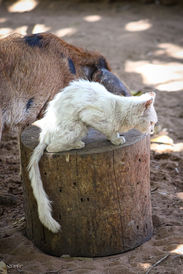


Hurdles and joys in small wildcats’ conservation: The Mirador tale
The Mirador State Park are the Brazil's second largest savanna (cerrado) protected area.
-
5.008 Km2
-
Good habitat integrity
-
12 mammals and 12 birds threatened
-
7 felids present
-
1000 people living within its borders
.png)
In 2014 a reportt suggests the park holds an important population of the globally threatened Leopardus tigrinus. Now despite its conservation importance, the park faces several threats. IUCN also highlights the park's importance for the species'
ll.png)
Main Threats

DEFORESTATION

HUMAN-INDUCED
FIRES

HIGH INCIDENCE OF DOMESTIC DOGS

HUMAN PRESENCE
Population monitoring: Part I
We studied tiger cats habitats preference. We found that 48% of the park is unsuitable fot the species! The veredict: Leopardus tigrinus avoids open savannas!

Diseases: the invisible threat
Population monitoring allowed us to explore its health. Dogs and foxes with clear signs of disease. Domestic dogs detected at 80% of sampled sites!


.png)
SHARING THE SAME PLACE AT ALMOST
THE SAME TIME!
Population viability
First population viability analysis ever done for a small neotropical cat! In the long term (1000 years), the population of Leopardus tigrinus dies out in the case of moderate disease outbreaks.
.png)
THE EFFECT OF HABITAT LOSS IN THE SHORT TERM IS ALSO DEVASTATING!
But...
With light disease outbreaks or no catastrophes at all, the Mirador population is viable in the long run (1,000 years)
.png)
The Invisible Threat: Part II
Diseases detected in all dogs tested until now:
-
Parvovirus
-
Canine distemper
-
Rabies
-
Dermatological diseases
We immediately implemented a vaccination program for domestic dogs in the park!
TARGETS

Ensure long-term population viability of leopardus tigrinus in its key worldwide conservation area: THREAT REDUCTION AND MITIGATION.

Encourage landowners to protect habitat patches within their properties and to keep their animals indoors.

Community involvment in conservation practices.

Monitoring population trends of L. tigrinus.

Habitat monitoring.

Establish a permanent castration and vaccination program.

Training of professionals and non professionals: creating a new generation of conservationists.
Current activities
Vaccination and castration of domestic dogs and cats inside the park.
Reducing and mitigating the threat of disease.
Vaccination card made specifically for Mirador. It brings information about the vaccines, good animal care practices, and immunization records.
Educação ambiental nas comunidades dentro e fora do parque!
Novos materiais educacionais e jogos!
Habitat monitoring
Monitoring the extent of the 2020 fires. Monitoring vegetation loss via satellite imagery.
Population monitoring
Monitoring L. tigrinus both in the park and in surrounding areas, bringing land owners to join small cat conservation and enchancing habitat connectivity.
Raising awareness
-
Workshops;
-
Photo expositions;
-
Seminars;
























